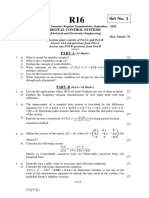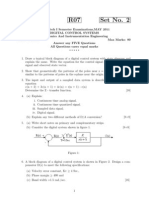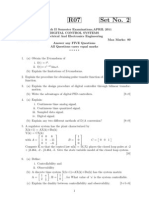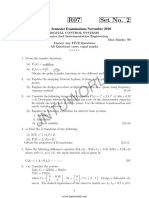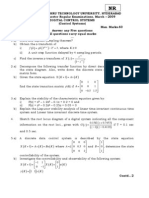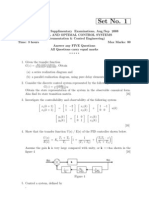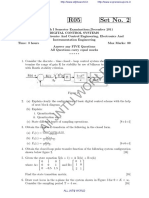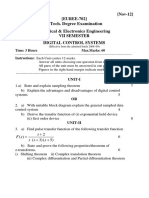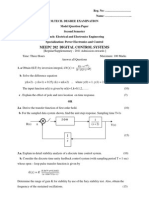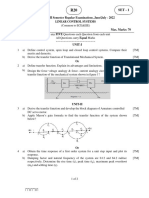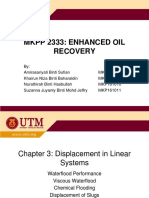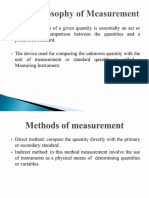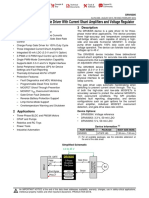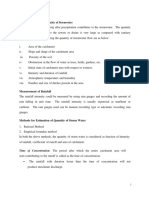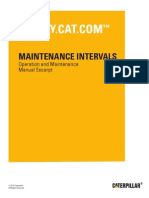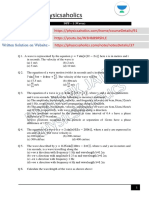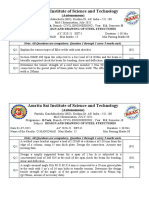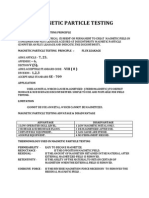Code No: RT42021 R13 Set No.
1
RT42021 IV B.Tech II Semester Regular Examinations, April/May - 2017
DIGITAL CONTROL SYSTEMS
(Electrical and Electronics Engineering)
Time: 3 hours Max. Marks: 70
Question paper consists of Part-A and Part-B
Answer ALL sub questions from Part-A
Answer any THREE questions from Part-B
*****
PART–A (22 Marks)
1. a) What are the advantages of sampling process in control systems? [4]
b) What is the property of linearity of Z-transforms? [4]
c) What are the different ways of state space representation? [4]
d) Write about the mapping of left half of the s-plane into the z-plane? [4]
e) How a pulse transfer function in z-plane is converted into a rational function
w-plane? [3]
f) What is Ackermann’s formula? [3]
PART–B (3x16 = 48 Marks)
2. a) What are the advantages and disadvantages of digital control systems? [8]
b) Give any one typical example of digital control systems and explain its
operation? [8]
3. a) Define Z transform. Calculate the Z-transform of the system having transfer
function, F(s); subject to a step input sampled at 3 Hz.
1
F ( s)
1 2s [8]
b) Solve the following differential equation using Z transform method
x(k+2) + 5x (k+1) + 6 x(k) = 0
Given that x(0) = 0, x(1) = 1 [8]
4. a) A linear time invariant system is represented by vector-matrix difference
equation
X(k+1) = AX(k) + BU(k)
Obtain X(k) by Z transform method. [8]
b) For a homogenous system given by
0 1
X ( k 1) X (k )
2 3
Obtain state transition matrix (k )
[8]
1 of 2
||''|''||''||''''''|
� Code No: RT42021 R13 Set No. 1
RT42021
5. a) Explain about the relation between location of closed loop poles in the z-plane [8]
and system stability?
b) Consider the discrete - time unity feedback control system (with sampling [8]
period T=1 sec) whose open loop pulse transfer function is given by
K (0.3679 z 0.2642)
G( z )
( z 0.3679)( z 1)
Determine the range of gain K for stability by using Jury stability test.
6. A block diagram of a digital control system is shown in the figure. Design a [16]
compensation D(z) to meet the following specifications.
i) Velocity error constant, K v 3 sec 1
ii) Phase Margin 50 0
iii) Band Width = 1.1rad / sec
7. a) Enumerate the design steps for pole placement [8]
b) Prove Ackermann’s formula for the determination of the state feedback gain
matrix K. [8]
2 of 2
||''|''||''||''''''|
� Code No: RT42021 R13 Set No. 2
IV B.Tech II Semester Regular Examinations, April/May - 2017
DIGITAL CONTROL SYSTEMS
(Electrical and Electronics Engineering)
Time: 3 hours Max. Marks: 70
Question paper consists of Part-A and Part-B
Answer ALL sub questions from Part-A
Answer any THREE questions from Part-B
*****
PART–A (22 Marks)
1. a) What are the advantages of digital control systems? [4]
b) What are the limitations of Z-transforms? [4]
c) Write the discrete time state equations of a pulse transfer function? [4]
d) Write about the primary and complimentary strips? [4]
e) What is bilinear transformation? [3]
f) What are the necessary and sufficient conditions in design via pole placement? [3]
PART–B (3x16 = 48 Marks)
2. a) Explain about the frequency-domain characteristics of zero-order hold? [8]
b) With suitable block diagram explain the sample and hold circuit. [8]
3. a) Obtain the Z-transform of the following function
s2
F ( s) 2 2
s s 2s 3 [8]
b) Solve for y(k) the equation
y(k ) r (k ) r (k 1) y(k 1), k 0,
r (k ) 1; k even, r (k ) 0; k odd , y(1) r 1 0 [8]
4. a) Explain the concepts of controllability and observability? [6]
b) Find the state model for the following difference equation and also find its
state transition matrix.
y(k+2) + 3y(k+1) + 2y(k) = 2u(k+1) + u(k)
Assume initial conditions are zero. [10]
1 of 2
||''|''||''||''''''|
�Code No: RT42021 R13 Set No. 2
5. a) State and explain Jury’s stability test [8]
b) Using Jury’s stability criterion, find the range of ‘M’
z 3 Mz 2 3Mz M 2 0 [8]
6. a) Explain the design procedure in the ω - plane of lag compensator. [8]
b) State the rules for the construction of root loci of a sampled data control
system. [8]
7. A discrete-time regulator system has the plant equation
2 1 4
x(k 1) x(k ) u (k )
1 1 3
y(k ) 1 1x(k ) 7u(k )
Design a state feedback control system with u(k ) Kx(k ) to place the closed
loop poles at 0.5 ± j0.5. [16]
2 of 2
||''|''||''||''''''|
� Code No: RT42021 R13 Set No. 3
IV B.Tech II Semester Regular Examinations, April/May - 2017
DIGITAL CONTROL SYSTEMS
(Electrical and Electronics Engineering)
Time: 3 hours Max. Marks: 70
Question paper consists of Part-A and Part-B
Answer ALL sub questions from Part-A
Answer any THREE questions from Part-B
*****
PART–A (22 Marks)
1. a) What are the different types of sampling operations? [4]
b) State and explain the shifting theorem of Z transforms [4]
c) What is the concept of observability [4]
d) State the Jury’s stability criterion [4]
e) What are the time response specifications [3]
f) Draw the block schematic of a closed loop control system (state space model) [3]
using a state feedback controller?
PART–B (3x16 = 48 Marks)
2. a) State and explain the sampling theorem for data reconstruction? [8]
b) Describe the operation of zero-order hold circuit? Obtain its frequency- [8]
domain characteristics?
3. a) Obtain the Z-transform of the following function
k
x(k ) a h , where ‘a’ is a constant.
h 0
[8]
b) Obtain the inverse Z-transform of the following in the closed form.
3z 2 2 z 1 z
(i) F ( z ) and (ii) F ( z ) 2
z 3z 2
2
z 0.3z 0.02 [8]
4. a) A discrete time system is described by the differential equation [8]
y(k+2) + 3y(k+1) + 4y(k) = u(k)
y(0) =1, y(1) = 1, T = 0.8 sec
Determine a state model in canonical form.
b) Explain the computation of state transition matrix. [8]
1 of 2
||''|''||''||''''''|
� Code No: RT42021 R13 Set No. 3
5. a) Explain bounded - input, bounded - output stability of a system [8]
b) Consider the system described by
Where
r(k) is the input and y(k) is the output of the system. Determine the stability
of the system. [8]
6. The open loop transfer function of a unity feedback digital control system is
given as
K ( z 0.5)( z 0.2)
G( z )
( z 1)( z 2 z 0.5)
Sketch the root loci of the system for 0 < K < ∞. Indicate all important
information on the root loci [16]
7. A discrete-time regulator system has the plant equation
0 1 0
x(k 1) x( k ) u (k )
1 1 1
y(k ) 1 1x(k )
The state feedback control is described by u(k ) Kx(k ) where
K K1 K 2 . Find the values K1 and K2 so that the roots of the
characteristic equation of the closed loop system are at 0.5 and 0.7. [16]
2 of 2
||''|''||''||''''''|
� Code No: RT42021 R13 Set No. 4
IV B.Tech II Semester Regular Examinations, April/May - 2017
DIGITAL CONTROL SYSTEMS
(Electrical and Electronics Engineering)
Time: 3 hours Max. Marks: 70
Question paper consists of Part-A and Part-B
Answer ALL sub questions from Part-A
Answer any THREE questions from Part-B
*****
PART–A (22 Marks)
1. a) Explain the principle of operation of zero-order hold? [4]
b) State initial and final value theorems of Z transforms? [4]
c) What is the concept of controllability? [4]
d) State the conditions for the Jury’s stability? [4]
e) Show that the steady-state error of a Type-1 system is zero for step-input? [3]
f) Why is pole-placement design necessary? Explain? [3]
PART–B (3x16 = 48 Marks)
2. a) What are the advantages of sampling process in control systems? Give the
mathematical description of ideal sampling process. [8]
b) Explain the advantages and disadvantages of digital control systems. [8]
3. a) Given the discrete time system
1 1 1
y (k ) y(k 1) y(k 2) u (k ) u (k 2)
2 4 3
Determine the pulse transfer function. [8]
b) Obtain the inverse Z-transform of the following in the closed form.
0.368 z 2 0.478 z 0.154
F ( z)
z 2 z 1 [8]
4. a) Given a state equation in continuous-time, how is it discretized to obtain the [8]
equivalent discrete-time state model? Describe?
b) Consider the discrete control system represented by the transfer function. [8]
1 1
z (1 z )
G( z )
(1 0.5 z 1 )(1 0.5 z 1 )
Obtain the state space representation in the diagonal form.
1 of 2
||''|''||''||''''''|
� Code No: RT42021 R13 Set No. 4
5. a) How are primary and complementary strips formed? Discuss? [8]
b) Consider the following characteristic equation
Determine whether or
not any of the roots of the characteristic equation lie outside the unit circle in
the z - plane. [8]
6. Draw the root locus in the z-plane for the system shown in figure for 0 < K <
∞. Consider the sampling period T = 2sec.
[16]
7. Consider system described by
with , and
Compute K so that the control law places the closed loop
poles at and -0.8. [16]
2 of 2
||''|''||''||''''''|
